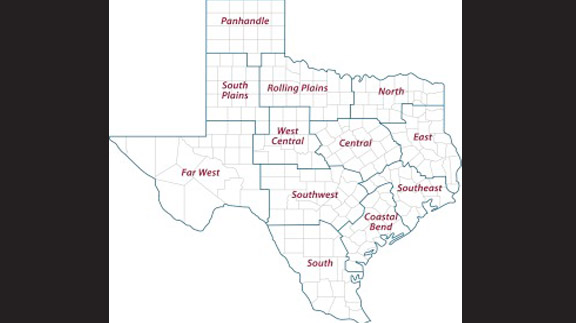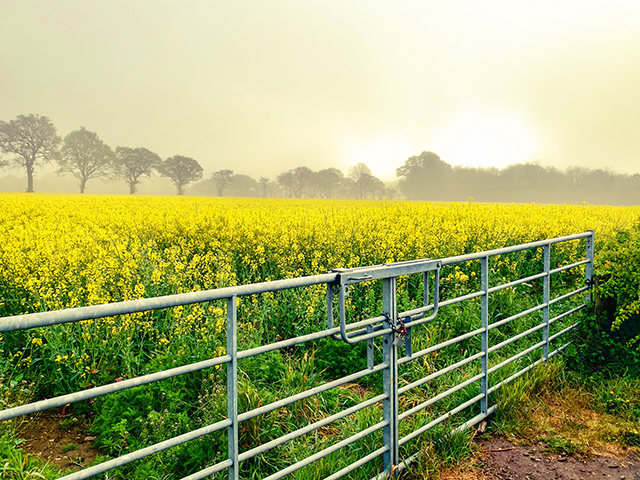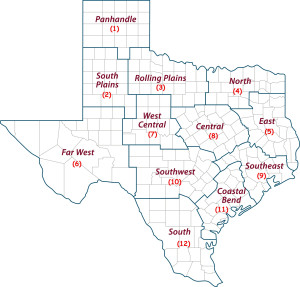Farm & Ranch
Texas crop, weather report for July 7, 2015

By: Robert Burns
One benefit of all the rains were fewer grasshoppers overall
Writer: Robert Burns, 903-834-6191, [email protected]
COLLEGE STATION – Though there have been reports of high grasshopper populations in some areas, generally the pest’s numbers statewide are much lower this year.
“Our expectations this year were that grasshopper numbers would be lower because during heavy rains and higher humidity, grasshoppers are more likely to die from fungal diseases, “said Dr. Allen Knutson, Texas A&M AgriLife Extension Service entomologist, Dallas. “We’re getting a few reports of grasshoppers, but overall the numbers are much less than in previous years.”
In the Central Texas Blacklands, only Ralph Davis, AgriLife Extension agent for Kaufman County, mentioned seeing large numbers of grasshoppers.
Download or preview a two-minute MP3 audio version of this report
In East Texas, Armon Hewitt, AgriLife Extension agent for Trinity County,
noted increasing grasshopper numbers, but his was the only county where troublesome numbers were reported. In the West Central District, Heath Lusty, AgriLife Extension agent for Lampasas County, noted that “lots of small grasshoppers were beginning to show up.”
Generally, however, the incidents of grasshoppers were low as was expected, Knutson said. This doesn’t mean producers shouldn’t be on the watch for the pest. It’s still possible for populations to explode in isolated areas.
Knutson also said that though incidences of the sugarcane aphid have been lower than expected this year, the pest is now showing up in Blacklands fields.
“We’re seeing some of the first sorghum fields in the northern Blacklands being treated for sugarcane aphids,” he said. “Also, forage sorghums should be monitored closely too for this pest, because it can be very damaging to crops like Sudan grass and haygrazer.”
Though the sugarcane aphid numbers haven’t increased until recently, now that hotter, drier summer days are here, populations can get out of control very rapidly, Knutson said.
AgriLife Extension district reporters compiled the following summaries:
Central: Rangeland, pastures, livestock and most crops were all rated as being in good condition. Drier conditions during the past week were favorable for crops. Grain sorghum in particular looked very good. Corn maturity was highly variable. The wheat harvest was completed with some low test weights and some sprout dockages. Stock-water tanks were full, and lake levels were up. Sugarcane aphids were found in many forage sorghum fields. As most producers will start harvesting sorghum silage very soon, some fields will have to be sprayed. Bermuda grass stem maggots were also found. Hay harvesting was proceeding well, with yields ranging from four to six round bales to the acre. Though oats in some fields were laid down by earlier high winds and heavy rains, the harvest was considered good. Irrigation of crops will start soon.
Coastal Bend: Some areas had a few short showers, but hotter, drier weather generally prevailed, which made good growing conditions for most field crops and forages. The hot, dry weather also allowed fieldwork and hay harvesting. Corn was maturing and drying quickly. Hay harvest continued with very good yields. Most grain sorghum neared being ready to harvest, although combining will be difficult in fields where the wind from Tropical Storm Bill caused lodging. Cattle were in excellent condition, and pasture grasses were knee high. Cotton and soybeans were progressing well, though some fields needed more moisture to reach full yield potential.
East: Weather around the region became more normal for this time of year. Producers were baling hay as fast as they could. Some pastures were still not traversable with heavy equipment due to water in low-lying areas. In Anderson County, some areas along the Trinity River were still under as much as 5 feet of water. Most counties had adequate subsoil and topsoil moisture. Brief afternoon showers caused problems for hay production. Most hay fields were producing more hay per acre than normal – as much as three bales per acre — but the quality was down due to the delayed harvest and producers not being able to make applications of herbicides and fertilizer in a timely fashion due to the rain. Livestock were in good condition. Horn fly populations were still stressing livestock. Cattle were loaded with flies. Vegetable growers were harvesting peas, corn and tomatoes to sell at local farmers markets. Mayhaw, blackberry a nd blueberry growers had another great season. Peach yields were light due to pressure from continued rain and the resulting plant diseases. Most counties had a good watermelon crop, except Panola County, where heavy rains fell at the wrong time, knocking many of the blossoms from the vines. Pecan scab was present in orchards and landscapes. Mosquitoes and houseflies were still a major threat and nuisance. Feral hogs and grasshoppers were active.
Far West: All counties reported rainfall from 0.7 inch to 2 inches, which kept pastures and crops green. Temperatures continued to be mild for this time of year. Livestock continued to do well. Replanted cotton looked good but was behind normal growth.
North: Topsoil moisture was mostly adequate. Weather was generally mild, with some areas receiving from 0.3 to 1 inch of rain. Corn looked a little better than it had earlier, though uniformity of stands was still an issue due to some fields having standing water throughout emergence. Summer pastures were doing well with grass growing at a great rate. Soybeans and grain sorghum looked good. Late-planted cotton emerged. Producers were harvesting hay where fields had dried out. Livestock were in excellent condition, and calves were doing well. Wild hogs continued to damage pastures and crops. Grasshopper populations were expanding in some areas.
Panhandle: The region was hot and dry for most of the week, with rain on the weekend. Some areas of Dallam and Hartley counties received from 0.1 to 0.45 inch, with 0.2 inch common. Hansford County got 0.75 to 1 inch. The progress of the wheat harvest varied, from being well along to just starting. In Deaf Smith County, wheat yields were about average. In Randall County, about 60 percent of wheat was harvested, with yields ranging from 30 to 60 bushels per acre. The Hansford County wheat harvest was nearly completed, with irrigated fields making from 45 to 60 bushels per acre. Some wheat fields had been taken over by weeds and were being plowed under instead of farmers spending money to spray the field. Irrigation of corn was active, and some producers were cultivating and side dressing the crop with anhydrous ammonia. Corn was behind in maturity in some areas. In Hansford County, early planted corn tasseled, but the late-pl anted corn was far behind in development. Grain sorghum varied in maturity as well. Deaf Smith County grain sorghum was doing well, with earlier plantings at the six-to-eight leaf stage. Late plantings ranged from just emerging to the three-leaf stage. Ochiltree County sorghum planting was just completed. Most Randall County sorghum was rated as being in excellent condition. High temperatures increased livestock’s water needs, and with no wind to turn windmills, some producers started hauling water.
Cattle were in good condition across the region, though some pastures were beginning to turn brown. Grasshoppers were moving out of drier rangeland into cropland causing some producers to make broader insecticide applications.
Rolling Plains: Conditions returned to normal in the region, with little to no rainfall over the past few weeks. The dry conditions allowed producers to finish planting cotton. Planted cotton was in good to excellent condition, with only a few acres being in poor shape due to excessive rainfall during planting. Soil moisture remained favorable, though later-planted cotton had a harder time getting started due to the lack of rainfall during the past several weeks. There was only low to moderate pressure from fleahoppers and thrips. Pastures and livestock were in good to excellent condition. Earlier rains gave rangeland the boost needed to meet grazing demand. Some ranchers were beginning to restock herds but were mindful that if rains stop, they don’t want to be overstocked. High cattle prices were also making producers cautious on restocking. Hay yields were excellent, and the peach crop outstanding.
South: Scattered showers continued throughout the South Region. Some areas received light showers and some received pretty heavy downpours — resulting in good rainfall amounts to add moisture to already adequate soil moisture conditions. In the northern part of the region, peanuts were developing nicely and flowering, and some producers were spraying the crop with fungicides. Corn and grain sorghum were maturing, and cotton was setting bolls. Rangeland and pastures remained in good condition, and cattle body-condition scores were excellent. Soil moisture was mostly adequate in the northern counties. In the eastern part of the region, rains kept temperatures under 100 degrees. Jim Wells County received from 0.5 inch to 2 inches, which kept fieldwork minimal. Kleberg and Kenedy counties did not receive any rain, but cotton and small grain crops were said to be the best in the past decade. Ranges and pastures were excel lent. Soil moisture was mostly adequate, with Kleberg and Kenedy counties having 80 to 100 percent surplus conditions. In the western part of the region, some areas received nearly 2 inches of rain. Coastal Bermuda grass producers had plenty of round and square bales laid out in fields throughout the area. Hay was for sale at dramatically reduced prices. The scattered showers delayed some field activities, but corn, sorghum and cotton were progressing well, and watermelon harvesting preparations continued. There was some insect pressure on cotton, but it was below the economic threshold for any pesticide applications. Pecans continued to make good progress. Soil moisture remained adequate in most of the western counties. In the southern part of the region, showers in Cameron County halted the harvesting of corn and grain sorghum. In Hidalgo County, rain held up the harvesting of sunflowers, sorghum and sugarcane. Harvesting of row crops and hay continued in Starr County despite ligh t showers. Willacy County received about 1 inch to 3 inches of rain, which stopped the grain sorghum harvest for about two days. Corn throughout the area looked good. Soil moisture was mostly adequate in the southern counties, with Willacy County having 50 percent surplus topsoil moisture.
South Plains: Crops in most of the region were off to a good start due to all the early season rains but needed more moisture soon to keep progressing. The Bailey County wheat harvest was ongoing with excellent yields. Cochran County cotton progress ranged from five to 12 true leaves. Even with the dry conditions, Cochran County corn and grain sorghum were making excellent progress. Peanuts were also doing very well. Lubbock County growers began irrigating grain crops as soils dried out. Many Lubbock County cotton fields were squaring, and grain sorghum ranged from just planted to the early boot stage. Early planted cornfields were tasseling, and sugarcane aphids were detected. In Garza County, cotton was progressing well in most areas despite high weed pressure. No insect pressure was reported. Rangeland and pastures were in excellent condition. Mitchell County cotton was growing fast and showed signs of squaring in early pl anted acres. Weeds were a problem in cotton fields there too. Shortly after a sand fighter cultivator was run over a field, new weeds emerged. Scurry County cotton was a little behind but was expected to catch up soon.
Southeast: Soil moisture varied widely but was mostly adequate to surplus, with Hardin, San Jacinto and Chambers counties having 100 percent surplus levels. Rangeland and pastures in those counties were mostly good to excellent, with good ratings the most common. Walker County producers were harvesting hay. In Montgomery County, warm temperatures and rain promoted grass growth, but wet conditions made it difficult to put up much hay. Chambers County producers were able to make some herbicide applications to hayfields, but very little was cut due to weather conditions. Fort Bend County producers were also able to cut and harvest hay despite scattered showers bringing from 0.5 inch to 1.7 inches of rain. The county, like much of the region, needed a few weeks of dry weather to enable sorghum growers to begin harvesting. Brazos County also had scattered showers across the entire county. Warm-season grasses were growing rapidly, an d grasshopper populations were increasing in some areas. Waller County corn was in poor condition due to too much water. Pastures continued to improve, and rangeland was in good condition. For the first time in weeks, Brazoria County did not have heavy showers during the reporting period. In Chambers County, rice acreage was about half what it was in 2014. Some organic rice was planted right up until the last week of June.
Southwest: Drier weather improved conditions throughout the counties, and soil moisture became more manageable. With good growing conditions and earlier rains, Gillespie County peach growers were expecting a record-setting year. Some areas had problems with grasshopper infestations. Livestock and wildlife were in excellent condition with good forages and grazing on rangeland.
West Central: Days were hot and windy with warm nights. There were a few scattered showers, but the wildfire potential increased as tall grass in fields dried out. The wheat harvest was completed in most areas, with fair yields reported. Row crops continued to make good progress with plenty of moisture and good growing conditions. Summer forage crops were being harvested for hay with very good yields. Grain sorghum fields looked good. Cotton planting was mostly finished in all areas, and most of the planted crop had emerged. Producers were spraying cotton fields for weed control and scouting sorghum fields for sugarcane aphids. Some had to spray to control the pest. Hay producers continued cutting and baling, with good yields and high quality. Some hay fields neared being ready for a second cutting. Rangeland and pastures further improved due to recent rains. Livestock remained in good condition. Flies continued to be an is sue, and small grasshoppers made their appearance. Pecan trees were doing well.
-30-
Farm & Ranch
Meanwhile, Back at the Ranch…

By Rayford Pullen | [email protected]
When May arrives, we start thinking about weed control. With two years of drought under our belts, grass grazed short and hay stocks depleted, what we do now will influence our forage conditions for the entire year. With 75 percent of our annual warm season forages made by July 15 in North Texas, we need to get the grass growing while the sun shines.
Speaking of the sun shining, the biggest deterrent to growing lots of grass is restricted sunlight, and the biggest sun blockers we have are weeds.
Have you noticed weeds are normally just slightly taller than your grass and are probably blocking 90 percent of the sunlight from reaching the grass itself? So obviously, we need to improve conditions, so sunlight reaches the plants we want to grow.
With grass extremely short, more sunlight is hitting the soil surface now, which in turn results in more weed seed germinating. With the moisture we have received, we expect an abundance of weeds this year.
To read more, pick up a copy of the May issue of NTFR magazine. To subscribe by mail, call 940-872-5922.
Farm & Ranch
Land Market Report: March Land Sales

By Jared Groce
Rural land sales are continuing on a steady pace for early spring, with prices holding very strong with the sell-to-list price ratios remaining very high, even on properties that have been on the market for a longer than usual time period. The total number of transactions are picking up once again as the spring selling season kicks off, and the average acreage continues to decrease.
Larger acreage properties seem to be in higher demand than smaller properties currently, with many buyers simply parking cash in real estate to hedge against inflation. Interest rates seem to have settled down and most experts agree that rates will be reduced by the fed this year. Some lenders have programs in place that allow the buyer to reduce their rates without having to go through a full refinance ordeal.
To read more, pick up a copy of the May issue of NTFR magazine. To subscribe by mail, call 940-872-5922.
Farm & Ranch
Texas FFA State Vice President Weston Parr

Future Farmers of America was founded by a group of farmers in 1928 with the mission of preparing the next generation of agriculture. It has done just that during its 95-year history, as the organization works to give back to others by following its motto, “learning to do, doing to learn, earning to live, living to serve.”
FFA is an organization made up of state associations, and at the helm of the Texas FFA is a team of 12 officers representing their respective areas within the Lone Star State. These individuals dedicate a year of their lives as they serve members, provide leadership, and work together with the state staff and board of directors to develop policy and lead the organization of over 177,000 members.
North Texas is represented by Area IV and Area IV, stretching from Wilbarger County to Bell County and from Runnels County to Grayson County. This year, those chosen to lead this great area are State President Isaac Hawkins Jr., Area IV, and State Vice President Weston Parr, Area V.
Parr is from the Sam Rayburn FFA chapter and the Area V Association, but the leader who now serves more than 19,100 members of Area V entered the FFA organization as a shy teenager who sat in the back of the room.
“I didn’t talk to a whole lot of people. I didn’t know what I wanted to do with my life or where I could see myself, so I wasn’t involved on my high school campus,” Parr recalled.
“Then I started FFA and slowly but surely, my ag teachers worked me into attending more contests, meeting new people, and speaking. I remember the first time I gave an officer speech to my chapter. I can still remember how embarrassing it was. To see the progression from that moment to speaking on stage at the state convention in front of thousands of people. Now I feel like I can enter the industry I want and be successful all because of what FFA afforded me for five years.”
There is not much Parr did not do during his time in high school. His contest participation included chapter conducting, wool judging, cotton judging, wildlife, and job interview, but his favorite was extemporaneous speaking, which he did not start until his senior year of high school.
“I wish I could go back to my freshman, sophomore, and junior years and start that sooner. I think if I had more time, I would have been more successful than I already was, but that was something I didn’t realize I liked at the time. I’m not naturally somebody who likes to speak in public, but it was actually my favorite,” Parr said.
Parr won several awards during his time competing. In 2023 alone, Parr earned the Texas FFA Service-Learning Proficiency title, was a National FFA Service-Learning Proficiency finalist, and a Texas FFA Extemporaneous Speaking finalist. In addition to his CDE and LDE events during high school, he showed commercial steers at Houston, and boilers at most major shows, participated in the county show with projects in ag mechanics, showed goats from time to time, and showed heifers until graduation.
“FFA provides invaluable resources and knowledge to be successful once you leave high school and you are out of the blue jacket for the first time. I have been a part of a lot of great organizations over the years, and they are all great in their own way, but in my opinion, FFA is the most successful at producing members of society who want to go and do something with themselves,” Parr said.
He was halfway through his time as Area V Association President and attending the national convention when he began to ponder the idea of running for state office.
“This is around the time when you usually figure out if you want to go through and be a state officer or you decide that area officer is your last run. I was unsure of where I wanted to go, but I knew I didn’t want to be done with FFA. I decided maybe it would be a good opportunity not only for me to make more friendships and connections, but also to give back to the program that allowed me to be able to do what I can do today,” Parr explained.
To read more, pick up a copy of the May issue of NTFR magazine. To subscribe by mail, call 940-872-5922.
-

 Country Lifestyles1 year ago
Country Lifestyles1 year agoScott & Stacey Schumacher: A Growth Mindset
-

 Equine8 months ago
Equine8 months agoThe Will to Win
-

 Country Lifestyles7 years ago
Country Lifestyles7 years agoStyle Your Profile – What your style cowboy hat says about you and new trends in 2017
-

 Country Lifestyles4 years ago
Country Lifestyles4 years agoAmber Crawford, Breakaway Roper
-

 HOME7 years ago
HOME7 years agoGrazing North Texas – Wilman Lovegrass
-

 Country Lifestyles7 years ago
Country Lifestyles7 years agoDecember 2016 Profile, Rusty Riddle – The Riddle Way
-

 Outdoor9 years ago
Outdoor9 years agoButtercup or Primrose?
-

 Country Lifestyles8 years ago
Country Lifestyles8 years agoJune 2016 Profile – The man behind the mic: Bob Tallman








